The Internet has exploded with AI-generated content since the advent of tools like ChatGPT! As a result, it has become increasingly difficult to trust the accuracy of the information on the web.
Today, when you read a blog post or a news article, can you ensure the information is 100% authentic? Well, there are several ways to spot AI content. I’m going to share some of them with you!
In this article, we’ll discover How to Detect AI-generated content. This article focuses on the need for AI content detection with helpful tips on distinguishing human-written content from AI content.
I hope this information helps you evade misleading AI content and browse the web with awareness. So, with no more delay, let’s get started!
How to Detect AI–Generated Content?
Now that we know the need for detecting AI content, let’s talk about the best ways to detect it.
1) Flag Specific Words
You’re peacefully reading a blog post on the Internet and all of a sudden come across a few fancy words that make you go, “Wait a minute! Is this ChatGPT?”
Sounds familiar? Well, one of the most common telltale signs of AI-generated text is the repetition of specific fancy words. Whenever you find the following words repeating in a piece of writing, you can be quite sure of AI usage.
Let’s look at ChatGPT’s favorite words below.
1) Landscape
ChatGPT uses the word ‘‘Landscape’ frequently in its content generation. Because of this excessive repetition, especially in the essay and paragraph formats, it becomes easy to guess!
Examples:
- “In the dynamic landscape of the digital era, businesses are constantly seeking innovative ways to connect with their target audience.”
- “Collaborating with content creators has become increasingly vital for individuals and businesses seeking to thrive in the digital landscape.”
How to fix: Rephrase the sentence or replace the word ‘landscape’ with backdrop, domain, setting, environment, etc depending upon the context.
2) Foster
Here’s another word that occurs commonly in ChatGPT content. Using this word will foster AI content in your blogs and articles!
Examples:
- “By adhering to the principles of value, authenticity, and consistency, businesses can leverage content marketing to not only promote their products or services but also to foster long-term relationships.”
- ‘’Whether you’re brainstorming ideas, jotting down dreams, or doodling in the margins, the act of writing allows your mind to wander, fostering innovative thinking and problem-solving skills.”
How to fix: Replace it with different words like promote, encourage, support, etc depending on your context.
3) Transformative
ChatGPT reiterates this word in every other AI content generation query. The problem is, that not every event is transformative. We don’t need such a heavy word to describe every occurrence in life. Sometimes, things are just ‘changing’!
Let’s look at some examples below!
Examples:
- “In the hustle and bustle of our daily lives, it’s easy to overlook the simple yet transformative act of journaling.”
- “Incorporating meditation into daily life can be a transformative journey towards a healthier and more balanced existence.”
How to fix: Replace it with some milder words like innovative, developmental, progressive, game-changing, etc.
4) Unlock / Unleash / Unravel
This word specifically makes its appearance within headlines, blog and video titles, ads, and other copywriting content. Ready to unravel a few examples? Let’s go.
Examples:
- “Unlocking the Power of Daily Journaling: A Key to Personal Growth and Well-Being.”
- “As we unravel the mysteries of this nocturnal enigma, the interplay between science and cultural interpretations sheds light on the complexities of the human mind and the delicate dance between consciousness and the ethereal world of dreams.”
How to fix: Replace it with words like uncover, liberate, free, release, etc.
5) Not just…but / Not only…but also
ChatGPT loves to exaggerate. That’s where the ‘not just…but’ sentence format comes in handy! Though, this one’s not that common. Let’s take a look at some examples.
Examples:
- “As businesses navigate the complexities of the modern world, honing communication skills becomes not just a strategy but a fundamental competency.”
- “By adhering to the principles of value, authenticity, and consistency, businesses can leverage content marketing to not only promote their products or services but also to foster long-term relationships.”
How to fix: The best way to fix this is by splitting the connected sentences into two independent ones. It may dial down the impact of the statement but will ensure it’s not flagged as AI.
6) Navigate
This one is another frequently used word in ChatGPT content. Navigate this one carefully! Following are some examples.
Examples:
- “Companies are navigating these challenges by refining policies, providing training, and continuously seeking feedback to adapt and improve.”
- “The benefits extend beyond the initial hours of the morning, influencing overall health, happiness, and the ability to navigate life’s challenges with resilience and vigor.”
How to fix: Replace it with simpler words like face, go through, sail, etc.
7) Tapestry
This is probably the favorite word of ChatGPT. Tapestry refers to a complex combination of things or events. You’ll find it in most of the artistic content you generate. But not everything has to be a tapestry. Some things are simply a combination!
Let’s look at some examples now.
Examples:
- “It shapes our perceptions, sparks creativity, and contributes to the tapestry of our shared existence, making life more vibrant, meaningful, and interconnected.”
- “Nature poems, like timeless melodies, weave a tapestry of emotions, colors, and sensations that resonate deeply within the artistic soul.”
How to fix: Replace it with a more general-use word like combination, assortment, blend, etc.
8) Realm
Nobody uses the word realm unless they are the ancient rulers of a faraway kingdom! But guess what, ChatGPT does! Following are some examples.
Examples:
- “This essay delves into the mysterious realm of sleep paralysis, exploring its causes, symptoms, and the cultural narratives that have woven tales around this enigmatic experience.”
- “Today, I want to share with you the exciting journey of stepping into the world of copywriting, a realm where words wield incredible power.”
How to fix: Either rephrase the entire sentence or replace the word realm with words like world, domain, field, or zone, depending on the context.
2) Check Sentence Length
Humans typically express themselves in simple and short sentences, unless we’re talking about creative content, like fiction.
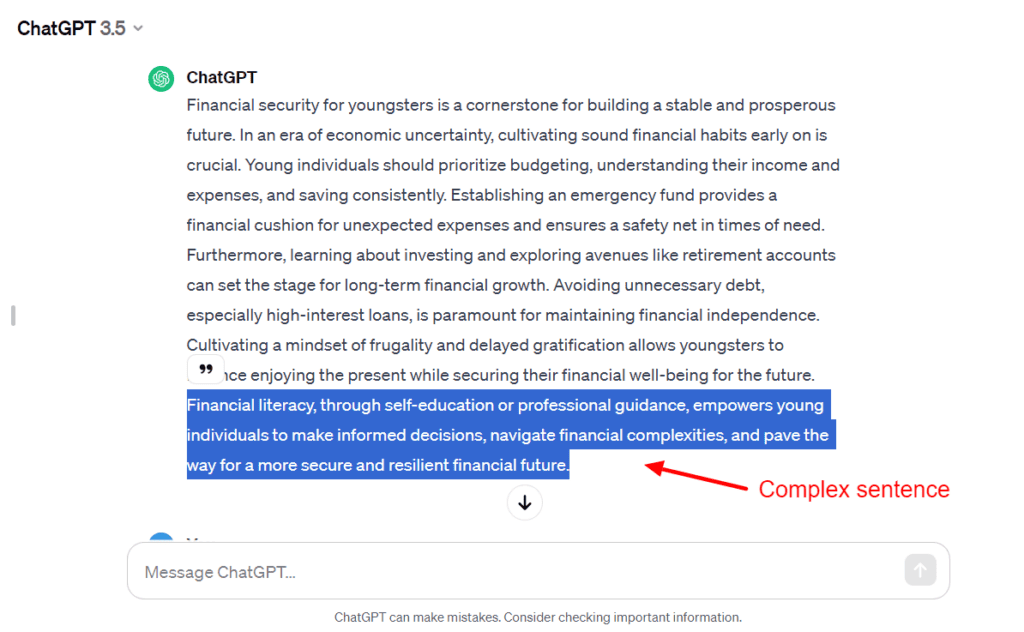
However, if you look at AI generation tools like ChatGPT, you’ll notice that they produce unbelievably long and complex sentences for most use cases. To fix this, you can try experimenting with your sentence length.
Besides giving it a human touch, this will also enhance the readability of your sentences. Gary Provost, an American Writer and Writing Coach, offers an insightful quote on sentence structure in his book “100 Ways to Improve Your Writing”.
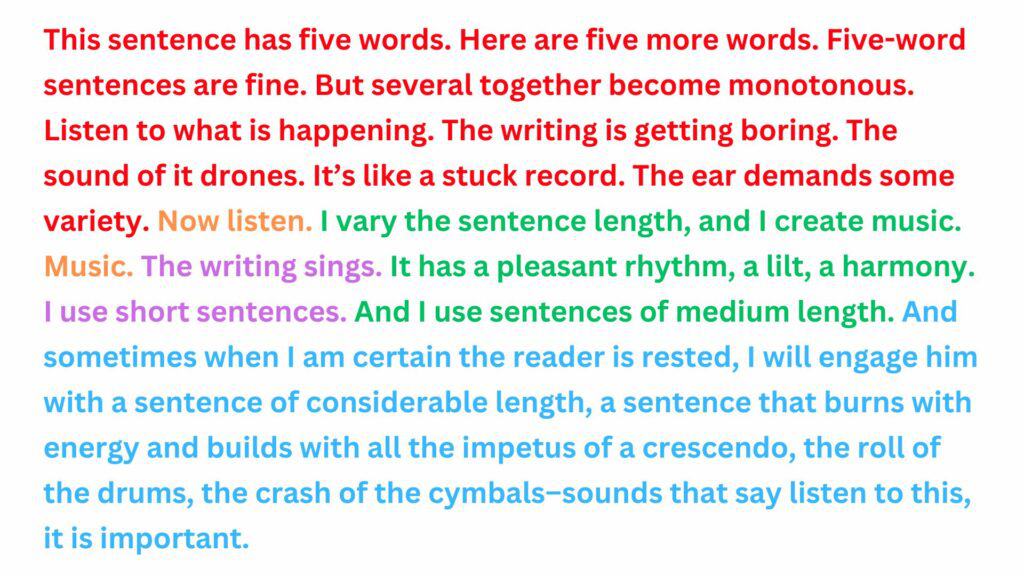
It may help you write sentences with varying lengths to keep the reader engaged throughout!
3) Look for Transitional Words
Excessive use of transitional words is a major hint of AI usage. ChatGPT loves transitional words like moreover, although, furthermore, however, ultimately, etc. Following are some examples:
- “Furthermore, waking up early allows for a more gradual and peaceful start to the day. Instead of rushing to get ready, individuals can take their time to savor a nutritious breakfast, plan their schedule, and mentally prepare for the day.”
- “However, when this state persists as one awakens or falls asleep, it results in the eerie sensation of being immobilized.”
- “Moreover, effective business communication is customer-centric.”
- “Additionally, regular meditation has been shown to enhance immune system function, promoting overall resilience to illness.”
- “Ultimately, nature poems serve as a symphony that resonates with the artistic soul on multiple levels. “
If you spot multiple occurrences of these words, you’re likely looking at AI-generated text.
4) Check Content Depth
AI tools are infamous for producing surface-level content. For example, if you ask ChatGPT to “write a paragraph about mobile phones”, it generates a paragraph equipped with facts and some generic information.
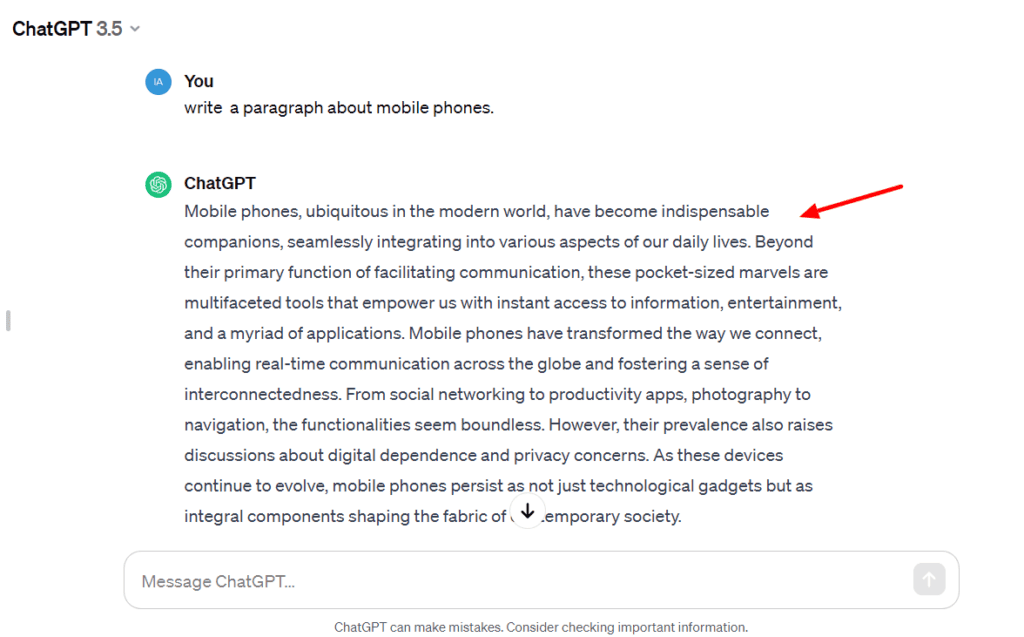
Unlike AI, humans usually dive into the intricacies of a topic. They tend to use relevant examples, tone and style inflections, stats and facts, personal opinions and biases, etc, to make their writeups more informative.
Content written by humans is targeted towards a specific audience and aims to achieve a specific goal. Whereas AI tools are simply good at gathering data and presenting it well. They lack the analytical abilities to create something useful out of that information.
So, while reading any articles or blogs online, always check for the depth and details presented in the content.
5) Look for Outdated Information
AI writers are only as good as their training data. For instance, ChatGPT has been trained on data until 2021. So, you cannot trust it for any information post 2021. For example, here’s ChatGPT’s response to my query about current affairs.
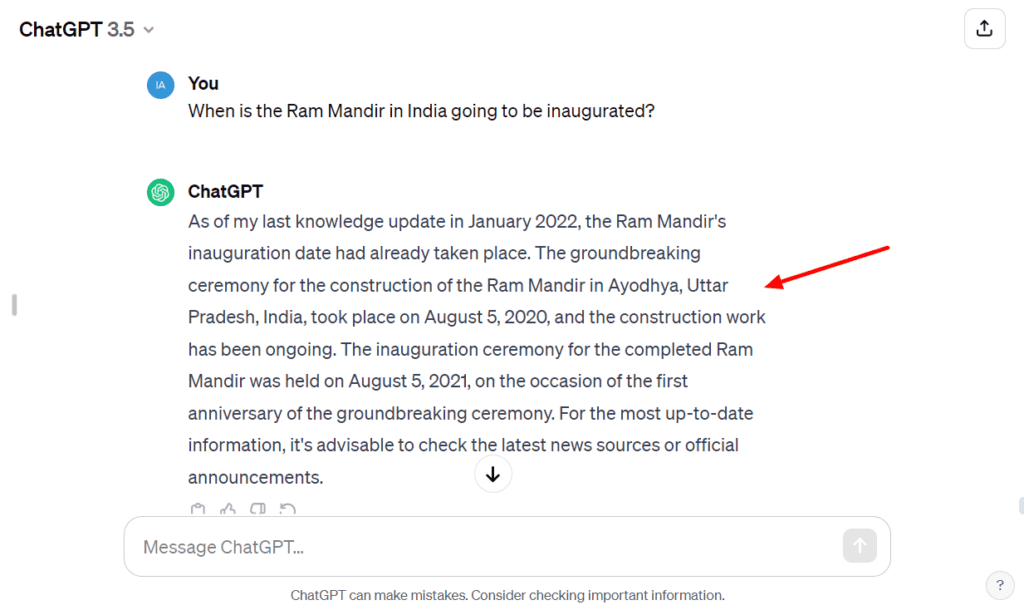
While reading any blog posts or articles online, always cross-check facts, citations, numbers, etc, for accuracy. Bing AI or Google Bard use real-time data, making them more efficient. So, when you ask the same query to these tools, they’ll give you accurate results.
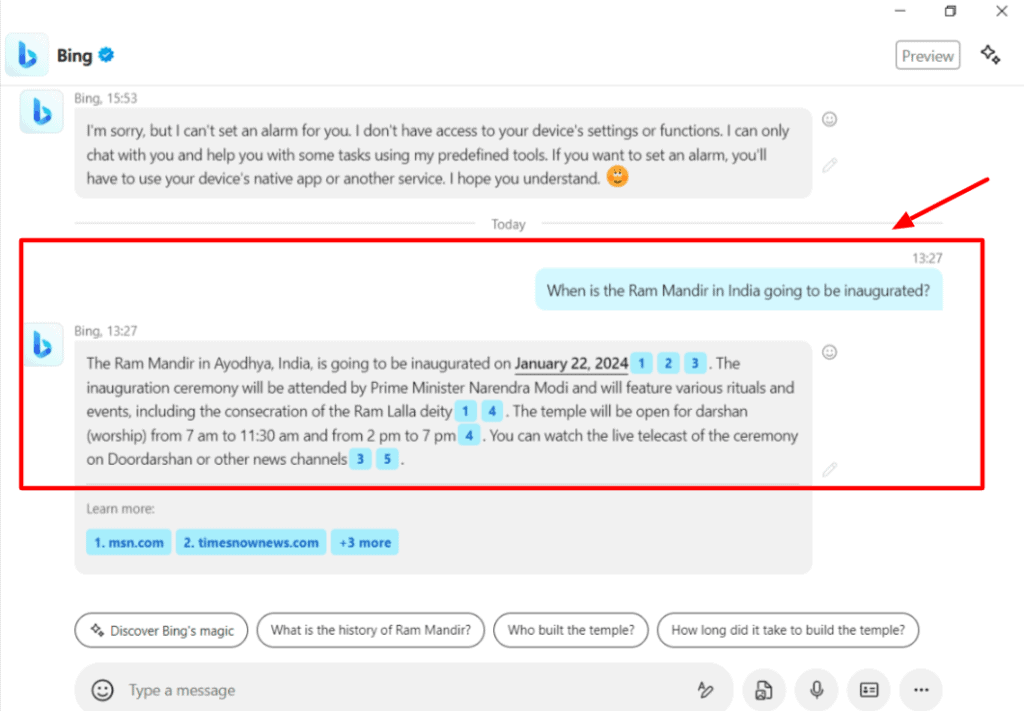
Thus, you can use Bing AI or Google Bard to get the latest updated data on any topic.
6) Analyze Personality and Emotion
Emotion is an inherent part of human writing. While reading content written by a human, you can sense a specific personality and writing style. That’s how we can distinguish between different authors.
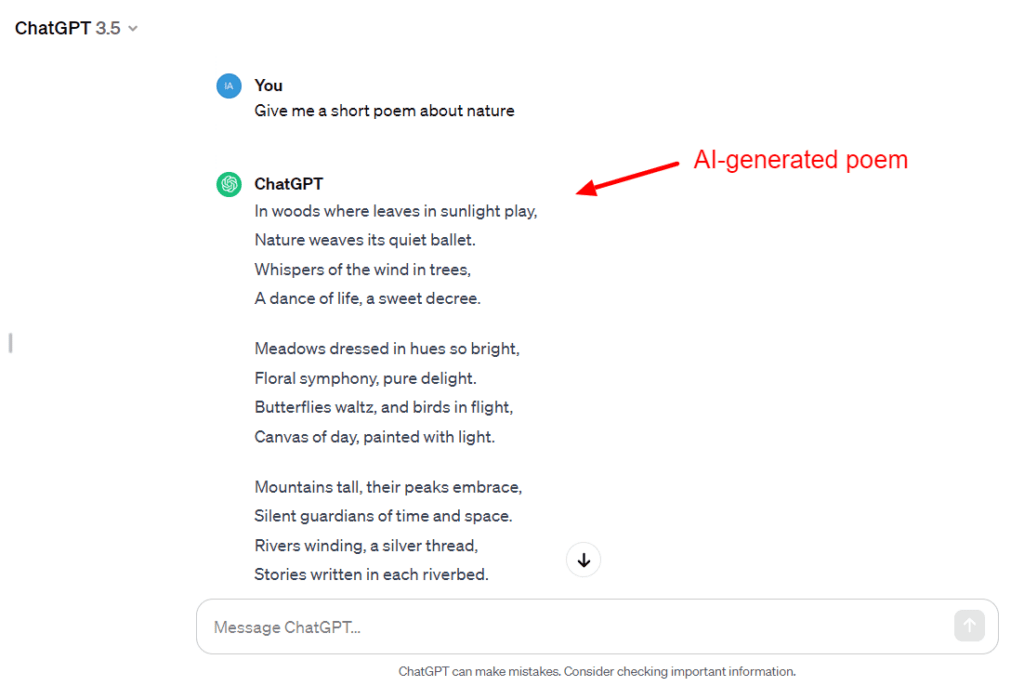
On the other hand, AI-generated content doesn’t invoke any emotions when you read it. Even poems written by AI may sound rhyming and musical upon initial reading, but the words just don’t stir your soul!
So, always look for a certain personality, humor, wit, and emotion in any writing to ensure it’s written by a human.
7) Spot Fancy Vocabulary
Complex words and fancy phrases are a dead giveaway of AI content. For example, here’s a simple, human-written text:
“As I started researching and experimenting with ChatGPT, a whole new world of possibilities unfolded before my eyes. To be honest, it scared me.”
And here’s the same sentence written by ChatGPT –
“Venturing into the realm of ChatGPT, my research, and experimentation unveiled a whole new spectrum of possibilities before my eyes. To be candid, it sent shivers down my spine.”
Notice how it used fancy words like venturing, realm, unveil, spectrum, candid, shivers, etc. If a sentence sounds too ornate with various fancy words, it is probably AI-generated.
8) Verify Author Credentials
When you come across a blog post that feels AI-generated, you can run a thorough check on the author’s credentials and background.
You can go through the other posts written by the author and compare them to understand his/her tone and writing style. If they don’t resemble the post in question, it’s likely AI content!
9) Run a Plagiarism Check
AI tools are trained on existing data. Thus, there is a fair probability of them generating phrases and sentences starkly similar to published content on the internet.
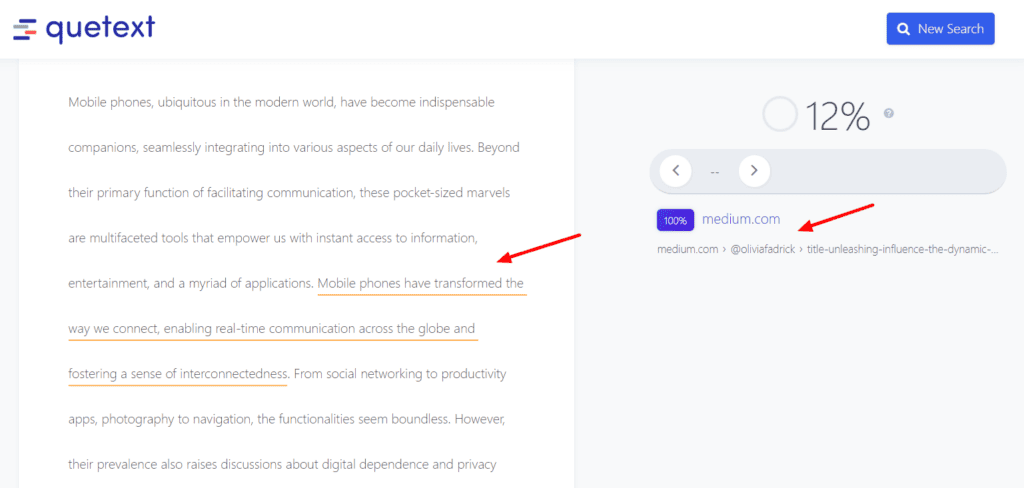
When in doubt, always run the content through a plagiarism checker to ensure it isn’t a copy-pasted version of some published post.
10) Use AI Content Detection Tools
Finally, if you’re still unsure about the authenticity of a piece of content, you can use AI content detectors. There are lots of free and paid tools available online to help you spot AI-written content. You can pick from our list of Best AI Content Detection Tools for 2024.
Why Do You Need to Detect AI Content?
Before jumping on to the ways of identifying AI-generated content, we need to first understand the need to detect it. What would happen if you let AI-generated content flood the internet? Let’s talk about it below.
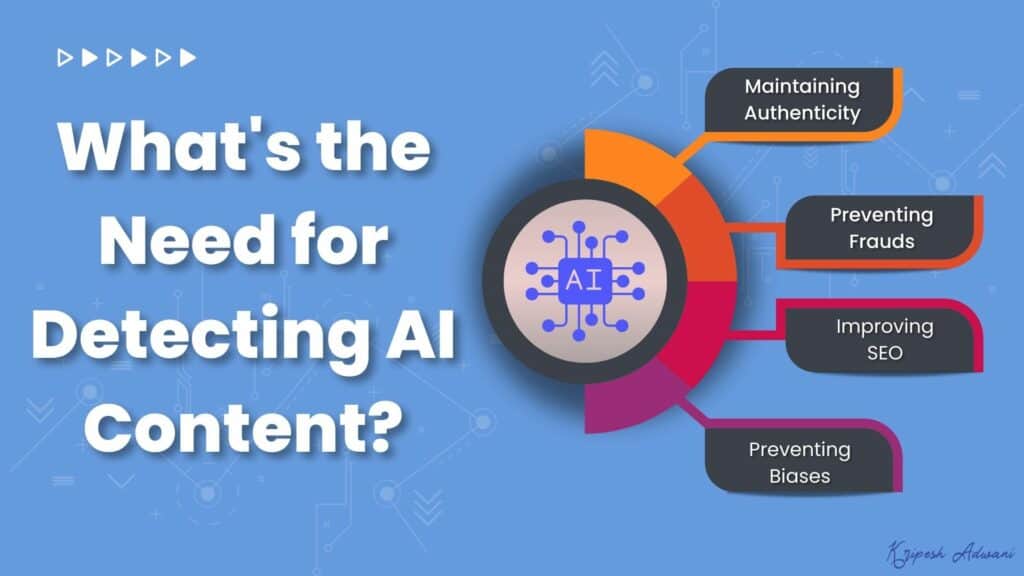
1) Maintaining Authenticity
Artificial intelligence tools can generate fake news articles, social media posts, essays, and blog posts. The fields of journalism, marketing, publishing, etc, are most prone to it.
Therefore, identifying AI-generated articles can prevent the spread of wrong information and maintain the integrity of the original sources of information.
2) Preventing Frauds
In the finance or cybersecurity domains, scammers may try to con people with fake emails and documents. Thus, AI detection protects users from falling into such traps.
3) Improving SEO
Google has stated that AI-generated content does not affect search rankings. However, it’s important to be careful with it. SEO content generated with AI may be stuffed with keywords just for the sake of it, hampering your SEO efforts.
Thus, it’s always best to detect AI content and edit it well before publishing it to maintain your search rankings.
Alternatively, if your work revolves around SEO, you can check out these Best ChatGPT SEO Strategies to optimize your content!
4) Preventing Biases
The type of content generated by an AI tool depends on the databases it’s trained on. If the training data has some discriminatory content, it may reflect in the results generated by AI as well!
Thus, detecting AI content could help eliminate potential biases in your content before it is available to the world.
Conclusion
With the rapidly growing AI technology, AI-generated content is bound to increase. I hope the tips mentioned in this article will help you spot AI content more effectively. Armed with this information, I’m sure you’ll be able to tread on the internet with awareness.
In my opinion, it’s not at all bad to use AI writing tools. AI technology makes your work simpler and boosts productivity. However, you must make sure it’s used wisely. For instance, if you’re a blogger, make sure to fact-check and effectively edit AI content before publishing it online.
Anyway, do you have any other tips for detecting AI-generated content? Do share with us in the comments below. This is Kripesh signing off! I’ll be back with more interesting posts soon. Till then, take care and keep learning. Cheers! 🙂

